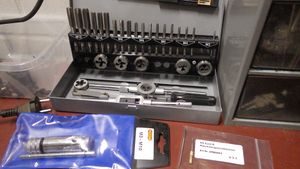Taps and Dies: Difference between revisions
No edit summary |
No edit summary |
||
| Line 1: | Line 1: | ||
{{ToolInfoBox | {{ToolInfoBox | ||
|tool name=Taps and Dies | |tool name=Taps and Dies | ||
| Line 7: | Line 6: | ||
|material=[[metal]], ''[[plastic]]'' | |material=[[metal]], ''[[plastic]]'' | ||
}} | }} | ||
Taps and dies are used to create or clean up threads, usually in [[metal]]. | Taps and dies are used to create or clean up threads, usually in [[metal]]. | ||
Revision as of 20:32, 2 March 2021
| ToolInfoBox Taps and Dies | |
|---|---|

| |
| Synonyms: | DE: Gewindeschneider |
| Material: | metal, plastic |
| Location: | metal workshop |
Taps and dies are used to create or clean up threads, usually in metal.
Three-stage taps need to be used in the correct order (from rough to fine). You can tell the order by judging how complete the cutting edge is or by the rings around the shaft: 1 ring -> 2 rings -> no ring.
Here's a makezine tutorial on using taps and dies.
Taps
| ToolInfoBox Taps | |
|---|---|

| |
| Synonyms: | DE: Gewindebohrer, "Innengewindeschneider" |
| Type: | bit |
| Material: | metal, plastic |
| Location: | metal workshop |
| Access Requirements: | read this page |
Taps can be ruined by incorrect use, please ask for help if you are new to them. Into anything harder than aluminum, they are driven by hand using a tap wrench (DE: Windeisen).
Did you know? The proper drill bit size for common thread diameters can also be found on the back of the digital caliper!
We've got a set of M3/4/5/6/8/10/12 three-stage taps with holders. Lmnl99 also brought in an M2 tap which only works with our holders when a piece of tape is wrapped around the shaft.
The rough M3 tap (one ring) was broken and is currently missing.
Dies
| ToolInfoBox Dies | |
|---|---|

| |
| Synonyms: | DE: Schneideisen, "Außengewindeschneider" |
| Material: | metal, plastic, very hard wood |
| Location: | metal workshop |
| Access Requirements: | read this page |
We have an assortment of dies of the following sizes:
| M3 |
| M4 |
| M5 |
| M6 |
| M8 |
| M10 |
| M12 |